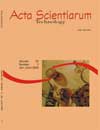<b>Statistic methods and population spatial structure: a comparative analyses</b> - DOI: 10.4025/actascitechnol.v28i2.1197
DOI:
https://doi.org/10.4025/actascitechnol.v28i2.1197Keywords:
ecologia de populações, dinâmica populacional, distribuição de Poisson, distribuição Binomial Negativa, distribuição agregada, pico de variânciaAbstract
This study aims to compare the results of spatial structure obtained between the classic and quadrat variance methods. Two species were analised, Vernonia aurea and Duguetia furfuracea. The Poisson distribution (random pattern), the Negative Binomial distribution (aggregate pattern), the BQV, TTLQV and PQV methods, the ratio variance:mean (I), the Green coefficient (Ig) and the Morisita´s index of dispersion (Im) were used to detect the populations spatial pattern. An aggregated spatial pattern distribution was detected through both methodologies, with similar results as for the aggregation level and the complementation of the information in different scales between classic and quadrat variance methods. Thus, the utilization of these statistic methods in studies of the spatial structure is recommended, given that tests are robust and complementary and field data samples are easy to collectDownloads
Download data is not yet available.
Downloads
Published
2008-03-20
How to Cite
Lima-Ribeiro, M. de S., & Prado, E. C. do. (2008). <b>Statistic methods and population spatial structure: a comparative analyses</b> - DOI: 10.4025/actascitechnol.v28i2.1197. Acta Scientiarum. Technology, 28(2), 219–224. https://doi.org/10.4025/actascitechnol.v28i2.1197
Issue
Section
Statistics
License
DECLARATION OF ORIGINALITY AND COPYRIGHTS
I Declare that current article is original and has not been submitted for publication, in part or in whole, to any other national or international journal.
The copyrights belong exclusively to the authors. Published content is licensed under Creative Commons Attribution 4.0 (CC BY 4.0) guidelines, which allows sharing (copy and distribution of the material in any medium or format) and adaptation (remix, transform, and build upon the material) for any purpose, even commercially, under the terms of attribution.
Read this link for further information on how to use CC BY 4.0 properly.











8.png)




